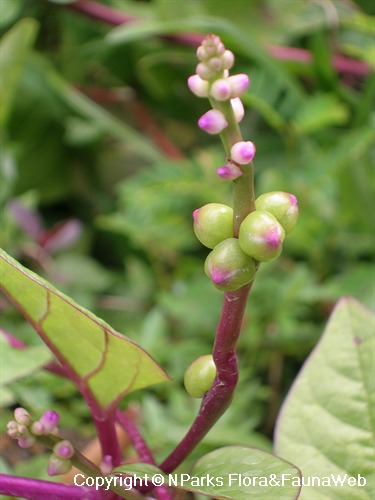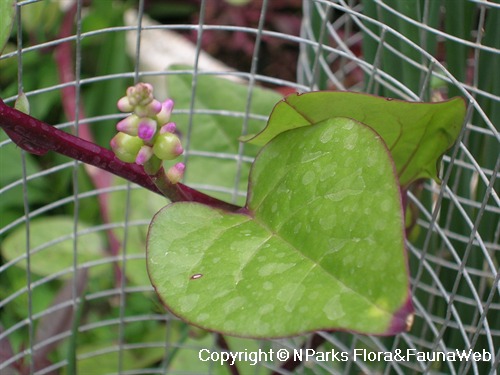
Back
Basella alba 'Rubra'
| Family Name: | Basellaceae |
| Synonyms: | Basella alba var. rubra, Basella rubra |
| Common Name: | Red Ceylon Spinach, Red-stemmed Malabar Spinach, Red Indian Spinach, Red Vine Spinach, Ang Chai, Gendola, Remayong, 红藤菜, 落葵, 紫落葵, 紫软藤, 紫背藤菜, 潺菜 |
Name
Classifications and Characteristics
| Plant Division | Angiosperms (Flowering Seed Plants) |
|---|---|
| Plant Growth Form | Climber, Creeper |
| Lifespan (in Singapore) | Semi-Annual / Annual-Like, Perennial, Annual |
| Mode of Nutrition | Autotrophic |
| Plant Shape | Leggy |
| Maximum Height | 3.5 m to 10 m |
| Maximum Plant Spread / Crown Width | 10 m |
Biogeography
| Native Distribution | Bangladesh, India, Sri Lanka, Cambodia, Laos, Myanmar, Thailand, Vietnam, Malesia, New Guinea |
|---|---|
| Preferred Climate Zone | Tropical |
Description and Ethnobotany
| Growth Form | Perennial herbaceous vine, creeping or climbing up to 10 m. |
|---|---|
| Foliage | Leaves green, oval, glossy and prominently veined. |
| Stems | Stems and petioles beetroot-red to purple and succulent. |
| Flowers | Flowers small and insignificant, produced in terminal or axillary spikes. |
| Fruit | Fruits are one-seeded indehiscent berries with persistent fleshy calyxes, ripening to purplish-black and containing purple juice, falling off readily from parent plant for self-seeding. |
| Others - Plant Morphology | Despite common names, the foliar resemblance and similar usage in food, plant is not a true spinach. Related to and differentiated from Basella alba, which has darker green leaves, green stems and white flowers.Fast-growing and grown in economic or vegetable gardens for food and as ornamental. Prefers moist, well-drained, rich loamy soils of pH 4.5 - 7.0. Use high-nitrogen fertilizer to speed up growth. Stems can be allowed to sprawl across ground or supported with trellises to encourage climbing. Minimize fungal diseases in leaves by improving air circulation or increasing amount of light. Propagate by seeds or stem cuttings - use stems around 20 cm long and trim large leaves to reduce transpiration loss before planting. If grown from seed, a crop can be harvested within 70 days. |
| Ethnobotanical Uses | Edible Plant Parts : Edible Leaves, Edible Stems Food (Herb or Spice) (Fruit or Vegetable): Young leaves and stems eaten raw in salads, as steamed vegetable, or used as thickening agent in stews and soups. Cooked leaves taste mildly of spinach, and are mucilaginous with slightly slippery texture. Rich in vitamins A and C, as well as iron, calcium and soluble fibre. Leaves can be infused in hot water to make a tea substitute. Purplish sap from fruits used as food colouring in jellies, pastries and sweets. Adding lemon juice intensifies the purple colour. Leaves and stems mildly laxative. Medicinal: Pulped leaves used as poultice to treat boils and sores. Cooked roots used to relieve diarrhoea, or as paste for swellings. Flowers used as antidote for poisoning. Juice from berries applied as eye-drops for conjunctivitis, and traditionally used in China to treat blood diseases. Others: Cultivated for centuries in China for red dye extacted from berries, which was used as ink for seals by court officials, and as facial rouge by women. Leaves also fed to livestock to improve milk production. |
Landscaping Features
| Desirable Plant Features | Ornamental Stems, Ornamental Foliage |
|---|---|
| Landscape Uses | Container Planting, Vertical Greenery / Green Wall |
| Thematic Landscaping | Economic Garden |
| Plant & Rootzone Preference or Tolerance Remarks | Optimal soil pH 4.5 - 7.0. Plants said to grow slowly in alkaline soils. |
Fauna, Pollination and Dispersal
| Fauna Pollination Dispersal Associated Fauna | Bird-Attracting |
|---|
Plant Care and Propagation
| Light Preference | Semi-Shade, Full Sun |
|---|---|
| Water Preference | Moderate Water |
| Plant Growth Rate | Fast |
| Rootzone Tolerance | Fertile Loamy Soils, Well-Drained Soils |
| Maintenance Requirements | Moderate |
| Diseases | Susceptible to root-knot nematodes (Meloidogyne spp.). May suffer from necrotic leaf spots caused by Cercospora basellae and Acrothecium basellae. |
| Propagation Method | Seed, Stem Cutting |
| Propagation Method Remarks | Use stems of around 20cm length for rooting. |
Foliar
| Foliage Retention | Evergreen |
|---|---|
| Mature Foliage Colour(s) | Green, Red |
| Mature Foliage Texture(s) | Smooth, Glossy / Shiny, Raised / Sunken Veins |
| Foliar Type | Simple / Unifoliate |
| Foliar Arrangement Along Stem | Alternate |
| Foliar Shape(s) | Non-Palm Foliage (Oval) |
| Foliar Venation | Pinnate / Net |
| Foliar Margin | Entire |
| Foliar Apex - Tip | Acute |
| Foliar Base | Cuneate |
| Typical Foliar Area | Microphyll ( 2.25cm2 - 20.25 cm2 ) |
Non - Foliar and Storage
| Stem Type & Modification | Herbaceous |
|---|---|
| Root Type | Underground (Fibrous Root) |
Floral (Angiosperm)
| Flower & Plant Sexuality | Bisexual Flowers |
| Flower Colour(s) | Pink, Purple, Red |
|---|---|
| Inflorescence Type | Spike |
| Flowering Period | Free-Flowering |
| Flowering Habit | Polycarpic |
Fruit, Seed and Spore
| Mature Fruit Colour(s) | Black, Purple |
|---|---|
| Fruit Classification | Simple Fruit |
| Fruit Type | Indehiscent Dry Fruit |
Image Repository
Others
| Master ID | 26 |
|---|---|
| Species ID | 1322 |
| Flora Disclaimer | The information in this website has been compiled from reliable sources, such as reference works on medicinal plants. It is not a substitute for medical advice or treatment and NParks does not purport to provide any medical advice. Readers should always consult his/her physician before using or consuming a plant for medicinal purposes. |










